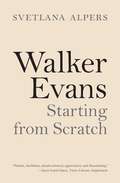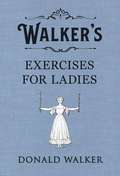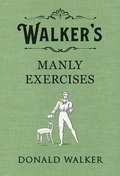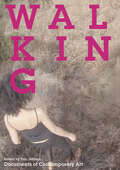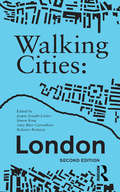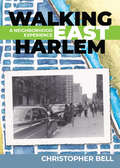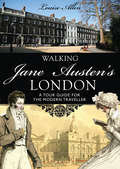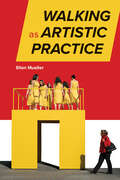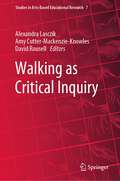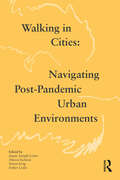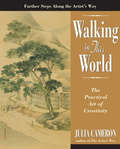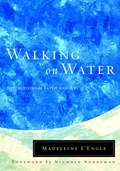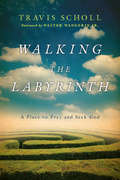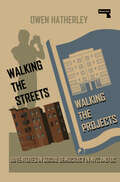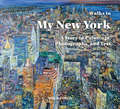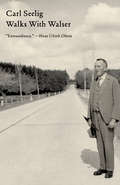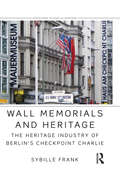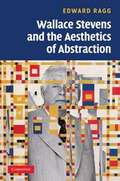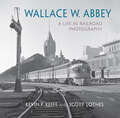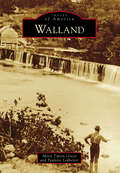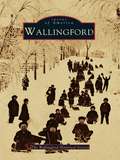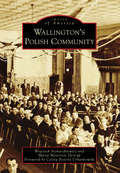- Table View
- List View
Walker Evans: Starting from Scratch
by Svetlana AlpersA magisterial study of celebrated photographer Walker EvansWalker Evans (1903–75) was a great American artist photographing people and places in the United States in unforgettable ways. He is known for his work for the Farm Security Administration, addressing the Great Depression, but what he actually saw was the diversity of people and the damage of the long Civil War. In Walker Evans, renowned art historian Svetlana Alpers explores how Evans made his distinctive photographs. Delving into a lavish selection of Evans’s work, Alpers uncovers rich parallels between his creative approach and those of numerous literary and cultural figures, locating Evans within the wide context of a truly international circle.Alpers demonstrates that Evans’s practice relied on his camera choices and willingness to edit multiple versions of a shot, as well as his keen eye and his distant straight-on view of visual objects. Illustrating the vital role of Evans’s dual love of text and images, Alpers places his writings in conversation with his photographs. She brings his techniques into dialogue with the work of a global cast of important artists—from Flaubert and Baudelaire to Elizabeth Bishop and William Faulkner—underscoring how Evans’s travels abroad in such places as France and Cuba, along with his expansive literary and artistic tastes, informed his quintessentially American photographic style.A magisterial account of a great twentieth-century artist, Walker Evans urges us to look anew at the act of seeing the world—to reconsider how Evans saw his subjects, how he saw his photographs, and how we can see his images as if for the first time.
Walker's Exercises for Ladies
by Donald WalkerFor ladies leading sedentary lives, Donald Walker has just the pep talk you need.If you haven't yet discovered the vast array of benefits that arise from physical exertion, then let Walker be your guide. As well as helping to prolong life and improve its happiness, active exercises can help you to achieve a beauty of form, elegant air and graceful manners.Through a combination of ladylike exercises such as dancing and dumb-bells, you can become the envy of all ladies.Tips include:- The posture and deportment that will enhance beauty- The correct manner of curtsy and what to do with one's hands when in company- Dangerous activities to avoid, from badminton to billiardsLavishly illustrated throughout, this guide has been brought back to life so that modern ladies can exercise the Victorian way.
Walker's Manly Exercises
by Donald WalkerFor gentlemen leading sedentary lives, Donald Walker has just the pep talk you need.If you haven't yet discovered the vast array of benefits that arise from physical exertion, then let Walker be your guide. As well as helping to prolong life and improve its happiness, active exercises can help you to achieve a beauty of form, elegant air and graceful manners.Through a combination of manly exercises such as leaping, skating and climbing trees, you can acquire the physique you desire and become the envy of all gentlemen.Tips include:· The correct way to walk at different paces - slow, moderate and quick· The best liquids to consume - primarily cold beer and cider · Permitted vegetable matter - including biscuits and stale bread Lavishly illustrated throughout, this Victorian guide has been brought back to life so that modern gents can exercise the manly way.
Walking (Whitechapel: Documents of Contemporary Art)
by Tom JeffreysWalking surveys the proliferation of pedestrian practices across contemporary art, taking an avowedly political stance on where and how the three practices of art, walking, and writing intersect.Across the world, walking is a vital way to assert one&’s presence in public space and discourse. Walking maps the terrain of contemporary walking practices, foregrounding work by Black artists, Indigenous artists and artists of colour, working-class artists, LGBTQI+ artists, disabled artists and neurodiverse artists, as well as many more who are frequently denied the right to take their places in public space, not only in the street or the countryside, but also in art discourse. This anthology contends that, as a relational practice, walking inevitably touches upon questions of access, public space, land ownership, and use. Walking is, therefore, always a political act.Artists surveyed includeStanley Brouwn, Laura Grace Ford, Regina Jose Galindo, Emily Hesse, Tehching Hsieh, Kongo Astronauts, Myriam Lefkowitz, Sharon Kivland, Andre Komatsu, Steve McQueen, Jade Montserrat, Sara Morawetz, Paulo Nazareth, Carmen Papalia, Ingrid Pollard, Issa Samb, Sop, Iman Tajik, Tentative Collective, Anna Zvyagintseva.Writers includeJason Allen-Paisant, Tanya Barson, André Brasil, Amanda Cachia, Sarah Jane Cervenak, Annie Dillard, Jacques Derrida, Dwayne Donald, Darby English, Édouard Glissant, Steve Graby, Antje von Graevenitz, Stefano Harney and Fred Moten, Elise Misao Hunchuck, Kathleen Jamie, Carl Lavery, JeeYeun Lee, Michael Marder, Gabriella Nugent, Isobel Parker Philip, Rebecca Solnit.
Walking Cities: London
by Jean-Luc Nancy Esther Leslie Douglas Murphy Phil Smith Steve Pile Ahuvia Kahane David Dernie Richard Wentworth Rosana Antoli Sean Ashton Rut Blees Luxemburg Amy Blier-Carruthers Duncan Jeffs Jaspar Joseph-Lester Adam Kaasa Nayan Kulkarni Sharon Kivland Laura Oldfield Ford Peter Sheppard Skærved Tom Spooner Peter St. John Jo StockhamWalking Cities: London (second edition) brings together a new interdisciplinary field of artists, writers, architects, musicians, human geographers and philosophers to consider how a city walk informs and triggers new processes of making, thinking, researching and communicating. In particular, the book examines how the city contains narratives, knowledge and contested materialities that are best accessed through the act of walking. The varied contributions take the form of short stories, illustrated essays, personal reflections and accounts of walks both real and fictional. While artist and RCA tutor Rut Blees Luxemburg and philosopher Jean-Luc Nancy recount a nocturnal journey from Shoreditch to the City of London; architect Peter St John of the practice Caruso St John offers a detailed and personal reflection on the Holloway Road; and architect and author Douglas Murphy examines what he calls London’s ‘more politically charged locations’ in his account of a solitary walk through an area of South London. Ultimately, Walking Cities: London seeks to understand the wider significance of changing geographies to generate critical questions and creative perspectives for navigating the social and political impact of rapid urban change.
Walking East Harlem: A Neighborhood Experience
by Christopher BellThey call it Spanish Harlem or sometimes just El Barrio. But for over a century, East Harlem has been a melting pot of many ethnic groups, including Puerto Rican, Dominican, Cuban, and Mexican immigrants, as well as Italian, Jewish, and African American communities. Though gentrification is rapidly changing the face of this section of upper Manhattan, it is still full of sites that attest to its rich cultural heritage. Now East Harlem native Christopher Bell takes you on a tour of his beloved neighborhood. He takes you on three separate walking tours, each visiting a different part of East Harlem and each full of stories about its theaters, museums, art spaces, schools, community centers, churches, mosques, and synagogues. You’ll also learn about the famous people who lived in El Barrio, such as actress Cecily Tyson, opera singer Marian Anderson, portrait artist Alice Neel, incomparable poet Julia De Burgos, and King of Latin Music Tito Puente. Lavishly illustrated with over fifty photos, Walking East Harlem points out not only the many architectural and cultural landmarks in the neighborhood but also the historical buildings that have since been demolished. Whether you are a tourist or a resident, this guide will give you a new appreciation for El Barrio’s exciting history, cultural diversity, and continued artistic vibrancy.
Walking Harlem: The Ultimate Guide to the Cultural Capital of Black America
by Karen TabornWith its rich cultural history and many landmark buildings, Harlem is not just one of New York’s most distinctive neighborhoods; it’s also one of the most walkable. This illustrated guide takes readers on five separate walking tours of Harlem, covering ninety-one different historical sites. Alongside major tourist destinations like the Apollo Theater and the Abyssinian Baptist Church, longtime Harlem resident Karen Taborn includes little-known local secrets like Jazz Age speakeasies, literati, political and arts community locales. Drawing from rare historical archives, she also provides plenty of interesting background information on each location. This guide was designed with the needs of walkers in mind. Each tour consists of eight to twenty-nine nearby sites, and at the start of each section, readers will find detailed maps of the tour sites, as well as an estimated time for each walk. In case individuals would like to take a more leisurely tour, it provides recommendations for restaurants and cafes where they can stop along the way. Walking Harlem gives readers all the tools they need to thoroughly explore over a century’s worth of this vital neighborhood’s cultural, political, religious, and artistic heritage. With its informative text and nearly seventy stunning photographs, this is the most comprehensive, engaging, and educational walking tour guidebook on one of New York’s historic neighborhoods.
Walking Jane Austen's London
by Louise AllenThe London of Jane Austen's world and imagination comes to life in this themed guidebook of nine walking tours from well-known landmarks to hidden treasures --each evoking the time and culture of Regency England which so influenced Austen's wise perspective and astute insight in novels such as Pride and Prejudice. Extensively illustrated with full-color photographs and maps these walks will delight tourists and armchair travelers as they discover eighteenth-century chop houses, elegant squares, sinister prisons, bustling city streets and exclusive gentlemen's clubs among innumerable other Austen-esque delights. - During Jane Austen's time, 1775 - 1817, London was a flourishing city with fine streets, fashionable squares and a thriving port which brought in good from around the globe. Much of this London still remains, the great buildings, elegant streets, parks, but much has changed. This tour allows the reader to take it all in, noting what Jane may have experienced while citing modern improvements such as street lighting and privies!
Walking as Artistic Practice
by Ellen MuellerWalking as Artistic Practice lays out foundational information about the history of walking and its development as an artistic practice, making it accessible to readers of all backgrounds. It also provides guidance on how to analyze and discuss walking artworks, with vocabulary support, over three hundred examples, and over seventy-five exercises. The chapters offer a variety of topical approaches, allowing readers and instructors to craft an experience most suited to their interests and needs. Themes include observational and sensory experience, leading versus following, who walks where (identity and positionality), rituals, place, activism, connections to drawing, and embodiment. Appendices include information on documentation, sample syllabi, readings and resources, brainstorming tips, community engagement guidance, and tips for travel-based study. Instructors will appreciate this text because it has so many resources to direct students to when they have questions about analysis, history, community engagement, or documentation approaches. It's the type of book that students will hang onto long after the course is done because it is so practical and useful.
Walking as Critical Inquiry (Studies in Arts-Based Educational Research #7)
by Amy Cutter-Mackenzie-Knowles Alexandra Lasczik David RousellThis book is a transdisciplinary, international collection situated within a genealogy of experimental walking practices in the arts, arts-based research, and emergent walking practices in education. It brings together emerging cartographies of relation amongst walking practices ranging across arts-based, ecological, activist, decolonising, queer, critical and posthuman modes of inquiry. Its particular investment is in the proliferation of artful modes of inquiry that open up speculative practices and concepts of walking as an orientation for pedagogy, inquiry, and the everyday, resisting the gaze of privilege and the relentless commodification of human and nonhuman life processes. This is important work for the burgeoning demand for creative methodologies in the social sciences, and more specifically, for arts-based educational research.
Walking in Cities: Navigating Post-Pandemic Urban Environments
by Simon King Esther Leslie Ahuvia Kahane Jaspar Joseph-LesterThis book brings together an international group of artists and writers to respond to the question of how our new world orders force us to reconsider urban walking and urban spaces in ways which extend into the digital sphere of online dialogue and screen sharing. In their reflections on walking cities in lockdown, the artists and writers contributing to this book share a number of complementary themes. Key to this is the question of how we walk in post-pandemic cities and how such walking might motivate or be motivated by transgressive, atomised or collective thoughts, affects, relations and experiences. Here we see how navigating cities in lockdown requires us to re-territorialise, improvise, create and de- or re-politize. There is, for example, a clear distinction between the severe lockdown measures that were introduced in Cape Town and the liberal appeal to good citizenship that northern hemisphere cities such as Stockholm chose to rely on. These measures impact on the way we experience urban walking and, in each case, lead to deeper reflections about the heightened presence of ideological structures embedded within the urban.
Walking in This World: The Practical Art of Creativity
by Julia CameronIn this long-awaited sequel to the international bestseller The Artist's Way, Julia Cameron presents the next step in her course of discovering and recovering the creative self.<P> Walking in This World picks up where Julia Cameron's bestselling book on the creative process, The Artist's Way, left off to present readers with a second course—Part Two in an amazing journey toward discovering our human potential. Full of valuable new strategies and techniques for breaking through difficult creative ground, this is the "intermediate level" of the Artist's Way program.<P> A profoundly inspired work by the leading authority on the subject of creativity, Walking in This World is an invaluable tool for artists. This second book is followed by Finding Water, the third book in The Artist's Way trilogy.
Walking on Water: Reflections on Faith and Art
by Madeleine L'EngleIn this classic book, Madeleine L'Engle addresses the questions: What makes art Christian? What does it mean to be a Christian artist? What is the relationship between faith and art? Through L'Engle's beautiful and insightful essay, readers will find themselves called to what the author views as the prime tasks of an artist: to listen, to remain aware, and to respond to creation through one's own art.
Walking the Labyrinth: A Place to Pray and Seek God
by Travis SchollOne day Travis Scholl discovered a labyrinth in his neighborhood. As he began to walk it, he found this ancient practice offered a much-needed path away from life's demands, allowing him to encounter God in quiet solitude. In this meditative guide, Travis Scholl takes readers on a journey: "The path is always new, because, as a spiritual discipline, the labyrinth is a tool for contemplation, for reflection, for prayer. Underneath the surface, walking the labyrinth is a profound exercise in listening, in active silence, in finding movement and rhythm in the stillnesses underneath and in between every day?s noise. Walking the labyrinth is an exercise in finding the voice speaking in whispers underneath the whirlwind of sound." With no end, but only a center, labyrinths become a physical symbol of prayer and our journey with God. Each step unites faith and action as travelers take one step at a time, living each moment in trust and willingness to follow the course set before them. Providing a historical and modern context for this unique spiritual discipline, Scholl weaves his own journey through a labyrinth with the Gospel of Mark's telling of the twists and turns of Jesus' life, providing 40 reflections ideal for daily reading during Lent or any time of the year.
Walking the Streets/Walking the Projects: Adventures in Social Democracy in NYC and DC
by Owen HatherleyA walk through the remnants of a social democratic America, and an argument about its future.In the 1960s, a novel ideology about cities, and what was best for them, emerged in New York. Pushing against the state planning of the time, it held that cities were at their best when they were driven from the bottom-up and when organic, unplanned processes were allowed to run their course, in a spontaneous "ballet of the street". Cities were at their worst, however, when the state stepped in, demolishing lively old neighbourhoods and erecting giant, sterile, empty "projects". This book uses the method of this ideology — walking — to test how true it actually is about the "capital of the twentieth century", New York City, with a brief interlude in the capital, Washington DC.The "projects" that are walked in this book range from cultural complexes in Manhattan to New Deal-era public housing developments in Brooklyn, Harlem and Queens, from the social experiment of Roosevelt Island to Communist housing co-operatives in the Bronx, from the union-driven rebuilding of the Lower East Side to DC's magnificent Metro. For all their many flaws, they prove that Americans could, in fact, plan and build fragments of a better society, which survive and sometimes thrive today in one of the unequal places on earth. Walking the Streets/Walking the Projects takes a hard look at these enclaves, and asks what a new generation of American socialists might be able to learn from them.
Walking, Landscape and Environment (Routledge Research in Landscape and Environmental Design)
by David Borthwick Pippa Marland Anna StenningWalking, Landscape and Environment explores walking as a method of research and practice in the humanities and creative arts, emerging from a recent surge of growth in urban and rural walking. This edited collection of essays from leading figures in the field presents an enquiry into, and a critique of, the methods and results of cutting-edge ‘walking research’. Walking negotiates the intersections between the human self, place and space, offering a cross-disciplinary collaborative method of research which can be utilised in areas such as ecocriticism, landscape architecture, literature, cultural geography and the visual arts. Bringing together a multitude of perspectives from different disciplines, on topics including health and wellbeing, disability studies, social justice, ecology and gender, this book provides a unique appraisal of the humanist perspective on landscape. In doing so, it challenges Romantic approaches to walking, applying new ideas in contemporary critical thought and alternative perspectives on embodiment and trans-corporeality.
Walks in My New York: A Story in Paintings, Photographs, and Text (No Ser.)
by Mikael OlrikThe acclaimed artist and architect shares a strolling, personal tour of a city that has become his creative muse and home away from home. Over the years, Danish architect and artist Mikael Olrik has developed a special relationship with New York City, finding endless inspiration in the vibrant and ever-changing metropolis. In Walks in My New York, Olrik shares his fascinating perspective on New York life through a combination of watercolor, photography and text. Olrik explores the city with the broad view of an architect, the specificity of an artist, the straight-forwardness of a photographer, and the companionable text of a diarist. He captures everything from street scenes of everyday life to pastoral views of Central Park and landmarks such as the Empire State Building and the Brooklyn Bridge. Small maps accompany each entry and act as a sort of &‘GPS&’ in print.
Walks with Walser
by Carl Seelig Anne PostenA unique and personal portrait of the beloved, legendary Swiss writer, finally in English After a nervous breakdown in 1929, Robert Walser spent the remaining twenty-seven years of his life in mental asylums, closed off from the rest of the world in almost complete anonymity. While at the Herisau sanitarium, instead of writing, Walser practiced another favorite activity: walking. Starting in 1936, Carl Seelig, Walser’s friend and literary executor, visited and accompanied him on these walks, meticulously recording their conversations. As they strolled, Walser told stories, shared his daily experiences of the sanatorium, and expressed his opinions about books and art, writing and history. When Seelig asked why he no longer wrote, Walser famously replied: “I’m not here to write, I’m here to be mad.” Filled with lively anecdotes and details, Walks with Walser offers the fullest available account of this wonderful writer’s inner and outer life.
Wall Memorials and Heritage: The Heritage Industry of Berlin's Checkpoint Charlie
by Sybille FrankAnalysing the transformation of Berlin’s former Allied border control point, "Checkpoint Charlie," into a global heritage industry, this volume provides an introduction to, and a theoretically informed structuring of, the interdisciplinary international heritage debate. This crucial case study demonstrates that an unregulated global heritage industry has developed in Berlin which capitalizes on the internationally very attractive – but locally still very painful – heritage of the Berlin Wall. Frank explores the conflicts that occur when private, commercial interests in interpreting and selling history to an international audience clash with traditional, institutionalized public forms of local and national heritage-making and commemorative practices, and with the victims’ perspectives. Wall Memorials and Heritage illustrates existing approaches to heritage research and develops them in dialogue with Berlin’s traditions of conveying history, and the specific configuration of the heritage industry at "Checkpoint Charlie". Productively integrating theory with empirical evidence, this innovative book enriches the international literature on heritage and its economic and political contexts.
Wallace Stevens and the Aesthetics of Abstraction
by Edward RaggEdward Ragg's study is the first to examine the role of abstraction throughout the work of Wallace Stevens. By tracing the poet's interest in abstraction from Harmonium through to his later works, Ragg argues that Stevens only fully appreciated and refined this interest within his later career. Ragg's detailed close-readings highlight the poet's absorption of late nineteenth century and early twentieth century painting, as well as the examples of philosophers and other poets' work. Wallace Stevens and the Aesthetics of Abstraction will appeal to those studying Stevens as well as anyone interested in the relations between poetry and painting. This valuable study embraces revealing philosophical and artistic perspectives, analyzing Stevens' place within and resistance to Modernist debates concerning literature, painting, representation and 'the imagination'.
Wallace W. Abbey: A Life in Railroad Photography (Railroads Past and Present)
by Scott Lothes Kevin P. KeefeWith over 175 images, this volume profiles the life and work of the legendary railroad photographer and the transformation of transportation after WWII.From the late 1940s onward, Wallace W. Abbey masterfully combined journalistic and artistic vision to transform everyday transportation moments into magical photographs. Through these images, Abbey helped people understand and appreciate what was often taken for granted: a world of locomotives, passenger trains, big-city terminals, small-town depots, and railroaders.A photographer, journalist, historian, and railroad industry executive, Abbey witnessed and photographed sweeping changes in the railroading industry from the steam era to the era of diesel locomotives and electronic communication. Featuring more than 175 exquisite photographs, Wallace W. Abbey is an outstanding tribute to a gifted artist and the railroads he loved.
Walland (Images of America)
by Missy Tipton Green Paulette LedbetterApproximately 10 miles long, Walland, Tennessee, is situated along the Chilhowee Ridge where the Little River naturally divides the mountain. Early on, both Baptist and Methodist churches were established, and the area�s Baptist church was the first permanent Baptist church in Blount County. Amerine Forge, operated by George Amerine, was the largest ironworks in Blount County from 1845 to 1860. In 1901, Schlosser Leather Company opened a tannery, making it the largest industry in the county.
Wallingford (Images of America)
by The Wallingford Historical SocietyWallingford lies nestled among the hills along thevalley of the Quinnipiac River in Connecticut. Its first settlers were 38 planters and their families, who arrived in 1670. The land proved to be productive for farming and orchards. Many years after its founding, Wallingford flourished as a center for the making of silver hollowware and flatware. With names such as Wallace, Simpson, Rogers, Elton, Hall, Miller, International Silver, the Community (a commune, which later joined the Oneida, New York community), and later Boardman, Wallingford became known throughout the country.Unique areas of Wallingford such as Yalesville, Tracy, Pond Hill, North Farms, and Cook Hill sprang up, taking on the names of the people who started businesses and farms there. Today, although most of the farms and the silver industry have disappeared, Wallingford still has a thriving industry and rural expanses. Revering its heritage, the community has worked hard to achieve this balance as it has gone forward to meet the challenges of the present and future.
Wallington's Polish Community
by Marta Mestrovic Deyrup Bozena Celina Urbankowski Wojciech SiemaszkiewiczThe years after World War I heralded a large influx of Polish immigrants fleeing war-torn homelands in search of a better life. Drawn by the opportunity to work in the textile and manufacturing mills, Polish immigrants moved to Wallington, New Jersey, a newly incorporated borough in Bergen County. The Polish community of Wallington established themselves as local store owners and businessmen. They constructed churches and social club buildings; established restaurants, pubs, and grocery stores; and participated in the social life of their community. By the 1920s, Polish Americans began to dominate local politics; in 1929, the first Polish American mayor, Leo Strzelecki, was elected. Polish Americans became the majority in Wallington between 1935 and 1945, representing about 70 percent of the population. In 2012, Polish Americans comprise over 50 percent of Wallington's population. Through vintage photographs that capture the spiritual life of these people and the struggles they overcame, Wallington's Polish Community honors the Polish immigrants of the past while educating new generations.

